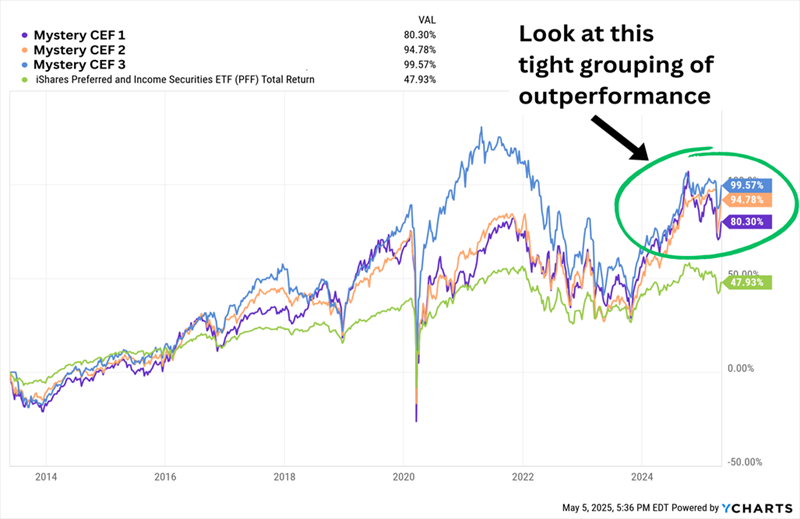“`html
Explore High-Yield Preferred Funds Offering Monthly Dividends
While many income investors focus solely on common dividends, savvy contrarians understand the superior benefits offered by preferred dividends. In this context, let’s discuss three preferred stocks that yield between 6.9% and 9.4%, providing monthly payouts for investors.
Understanding Preferred Dividends
Preferred dividends enjoy preferential treatment compared to common stock dividends, making them a safer option for income-seeking investors. There are four primary methods to invest in preferreds, but three come with significant drawbacks:
- Individual Preferred Stocks: Resources for researching individual preferred shares are limited and often require costly subscriptions. Investing in individual preferreds necessitates substantial capital to diversify, along with self-management of the portfolio.
- Preferred Mutual Funds: Mutual funds alleviate some challenges associated with buying individual preferreds and offer monthly payouts, unlike many individual shares that pay quarterly or semiannually. However, these funds often come with high annual fees and may charge front-end sales loads, adversely affecting performance. Additionally, they usually mandate minimum investments in the thousands of dollars.
- Preferred Exchange-Traded Funds (ETFs): ETFs possess many of the advantages of mutual funds. They usually have lower fees, no investment minimums, and can be traded throughout the day. However, because they often mirror index strategies, they may miss opportunities to capitalize on discounts compared to actively managed funds. As a result, performance can sometimes be less impressive.
- Preferred Closed-End Funds (CEFs): CEFs blend characteristics of both mutual funds and ETFs. Managers can capitalize on market opportunities while CEFs trade throughout the day without investment minimums—only the share price is needed. These funds can leverage debt to enhance returns and use options to further increase income. CEFs are not tightly bound to their net asset value (NAV), sometimes offering discounts that allow investors to acquire underlying assets for less. Therefore, despite higher fees, their performance can often justify the cost.
Performance Comparison: CEFs vs. ETFs
Data shows that CEFs generally outperform their ETF counterparts. A recent analysis comparing three preferred stock CEFs to the iShares Preferred and Income Securities ETF (PFF) indicates that all three CEFs deliver superior returns:
PFF Versus Preferred CEFs: The Price of Popularity

That said, preferred CEFs are not without challenges. Their fees are higher, and the use of leverage can cause more significant fluctuations compared to ETFs and mutual funds. Additionally, during market rallies, CEFs might trade at a premium to NAV, which could hinder performance if purchased at unfavorable times.
Top Three Monthly Dividend-Bearing Preferred CEFs
Now, let’s examine three preferred funds that provide monthly dividends, with yields up to 9.4%:
1. John Hancock Premium Dividend Fund (PDT)
Distribution Rate: 7.8%
First on the list is the John Hancock Premium Dividend Fund (PDT), a “hybrid” fund that strikes a balance between preferred stocks and dividend-yielding common stocks. This allocation is roughly 50/50, combining two income-generating strategies that could prove advantageous in the current market landscape.
Managed by a skilled team, PDT includes about 125 holdings. It features a significant share of utilities and financials, with top positions in high-yielding stocks like telecoms AT&T (T) and Verizon (VZ), alongside utilities such as Duke Energy (DUK) and BP (BP). Additionally, it holds 7.56% series from Citizens Financial.
PDT has consistently outperformed traditional preferred ETFs, such as the iShares Preferred and Income Securities ETF (PFF), thanks to its equity exposure and a leverage rate of 34%, allowing it to benefit from bullish market conditions.
Performance Comparison of Hybrid Funds

The tradeoff for PDT is increased volatility. While standard preferred funds may stabilize a portfolio, the added equities and leverage of this fund lean towards performance rather than safety. Fortunately, PDT has demonstrated its ability to provide strong returns, especially when trading at a discount to NAV—a situation currently in play, with PDT trading at a 6% discount, a notable shift from its previous premium trends over the last five years.
2. Flaherty & Crumrine Dynamic Preferred and Income Fund (DFP)
Distribution Rate: 6.9%
For traditional investors, the Flaherty & Crumrine Dynamic Preferred and Income Fund (DFP) may be appealing due to its straightforward focus on preferreds.
DFP boasts around 250 holdings, with nearly 80% coming from financial firms. It is categorized as a global fund, with about 70% invested domestically and 30% internationally. This diversification strategy helps mitigate risk while still capitalizing on the income potential from preferred stocks.
“`# Preferred Securities: Navigating Risks and Rewards in Income Investments
Morgan Stanley (MS) provides investors exposure to preferred stocks from Lloyds Banking (LYG) and Banco Santander (SAN). This strategic investment approach includes a significant portion of below-investment-grade assets. About half of the portfolio is classified as such, while DFP boosts performance and yield with nearly 40% debt leverage.
## DFP’s Risk-Reward Strategy
DFP Takes Risks to Earn Rewards

Flaherty & Crumrine’s preferred closed-end fund (CEF) presents an attractive headline pricing at an 8% discount to NAV. In comparison to its five-year average discount of approximately 2%, it appears to be a compelling choice for investors seeking value.
First Trust Intermediate Duration Preferred & Income Fund (FPF)
Distribution Rate: 9.4%
Most preferred stocks are perpetual, lacking expiration dates. Therefore, duration is usually not a primary consideration for preferred-stock funds. However, First Trust Intermediate Duration Preferred & Income Fund (FPF) takes a different approach, targeting a portfolio duration of three to eight years, currently averaging around five years.
## Overview of FPF’s Investment Strategy
By focusing on duration, FPF resembles a conventional preferred CEF. Financials represent the majority of its assets. The fund also includes a substantial international component, with over 40% of assets held outside the U.S., and Canada alone accounting for 15%. FPF employs a high leverage ratio of 34%, supporting its approximately 10% monthly dividend payouts.
FPF Outperforms iShares’ Preferred ETF

Two notable aspects of FPF are its credit quality and volatility. Approximately two-thirds of its assets are invested in investment-grade preferred securities, with around 15% in BB+, the highest rating within the junk category. This credit profile explains why FPF, while superior to PFF, has not outperformed the other two funds. However, it is also the reason FPF exhibits the lowest volatility (measured by beta) across significant time frames.
Currently, FPF trades at a 5% discount to NAV. Interestingly, its five-year average is slightly higher at 6%, providing an opportunity for investors seeking stability.
## Generating Income with Preferred CEFs
A Fully Paid Retirement for Just $500,000?
Preferred CEFs are appealing due to their potential for substantial monthly dividends. With a portfolio yielding 8% or more, one can expect $40,000 in dividends on a $500,000 investment.
For those with a million-dollar portfolio, anticipated dividends could exceed $80,000 annually. Best of all, these payments arrive every 30 days, allowing for consistent cash flow without the complexity of irregular payment schedules.
This structured income results in a smoother transition into retirement, mimicking the predictability of a regular paycheck.
Don’t miss opportunities in these attractive income investments available at favorable valuations.
Consider exploring these options:
- Warren Buffett Dividend Stocks
- Dividend Growth Stocks: 25 Aristocrats
- Future Dividend Aristocrats: Close Contenders
The views and opinions expressed herein are those of the author and do not necessarily reflect those of Nasdaq, Inc.



